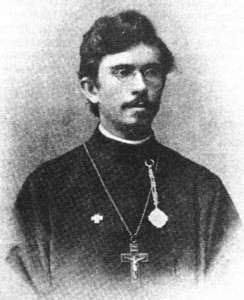Leaving aside Native Alaskans and Uniates, conversions to Orthodoxy in America were quite rare at the turn of the last century. Yes, American women occasionally converted when they married cradle Orthodox men, and there was the odd Episcopalian convert, but even taking those into consideration, conversions were very uncommon. And if Protestants joining the Orthodox Church were rare, a Jewish convert was rarer still. In fact, I’ve found only one solid example of a Jewish convert to Orthodoxy in America in the early years of our history.
We don’t know his name, or his story, but the event was sufficiently notable that the New York newspapers reported on it. The convert — baptized with the name “Vladimir” — was received on Sunday, February 14, 1897, at St. Nicholas Russian Church in New York City. The convert, described by the New York Times (2/16/1897) as “young,” renounced the “false doctrines of the Hebrews,” including the teachings of the Talmud. He swore that he was joining the Church only out of genuine conviction of faith and love for Christ, and not because of fear, coercion, the hope of personal gain, or any other reason. While the Hours were read, a wooden baptismal font was filled with water. The font was behind a low screen, which blocked the baptism from the view of the congregation. From the New York Sun (via the Atlanta Constitution, 2/25/1897):
The priest, the convert and the male sponsor went behind the screen. The woman sponsor staid [sic] outside. The screen was not high and the congregation could some times see garments that were raised in the convert’s complete disrobing. They could hear the solemn words of the service by those within. They could hear the splashing and gurgling of the water as the convert was immersed for the first, second and third time. They saw the symbolical white robe and the cross as they were raised above his head. Meanwhile they joined in singing the hymn of baptism.
The ceremony coincided with the Feast of the Entrance of Christ into the Temple, and the officiating priest was St. Alexander Hotovitzky. Presumably, St. Alexander played a major role in bringing this young Jewish man to Christ. But how, exactly, did a young New York Jew come to join the Russian Orthodox Church in 1897, just two years after St. Nicholas parish was founded? What effect did this conversion have on his life? Was he unique, or were there other Jews who converted around the same time? It’s likely that a record of this baptism still survives, perhaps in the OCA archives, and it’s possible that the Vestnik, the official diocesan publication, may have mentioned the event, so information is out there to be found.
In many ways, the conversion of a Jewish man to Orthodoxy in New York in 1897 is just as remarkable as the conversion of the black Jamaican Fr. Raphael Morgan a decade later. And, as with Morgan, this anecdote leaves us wondering about the rest of the story. Hopefully, one day, we will learn more.

Perhaps “Vladimir” was originally a Russian Jew. Conversions from Judaism to Orthodox Christianity were not unknown in Russia. This might explain why the convert was received into the Russian Orthodox Church.
Fr. David,
That’s my take on it, too. There’s a fascinating book out there worth reading, by Judith Deutsch Kornblatt, entitled Doubly Chosen. I read through it quickly at one point while looking into convert literature for my dissertation. Here is a book review by Dr. Scott Kenworthy (who is Orthodox):
http://muse.jhu.edu/journals/journal_of_the_american_academy_of_religion/v074/74.1kenworthy.html
From the Holy Trinity website, under 1891
05.16.SF.Examiner.html :
“Levin, who is a bright and intelligent young Russian, nearly twenty years old, of Jewish parentage, states that about three years ago, while at the home of his parents in Russia, Vladimir, commonly known as Basil Sokolowsky, persuaded the lad to accompany him to California, holding out the promise that he would have him educated for the priesthood. There were twenty boys in the party who came with the bishop at the time. The Russian Government allowed the Bishop 800 rubles for each boy whom he brought with him to defray the cost of the trip and expenses incident to their education. Young Levin alleges that he has received no education whatever, but that he was employed by the Bishop as a servant for two years, at the end of which time the Bishop sent him to Killisno, Alaska, there to promulgate the Greek-Catholic faith among the natives, promising to send him money for expenses. But the money never came, and the youth, after waiting patiently for almost a year and being almost on the brink of starvation, managed to return to this city and laid his complaint before the Bishop, who, however, refused to receive the young man, refused to compensate him for his two years’ services, his outlay while in Alaska and expelled him from the church.”